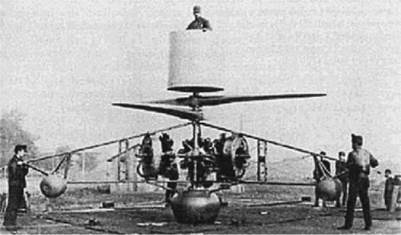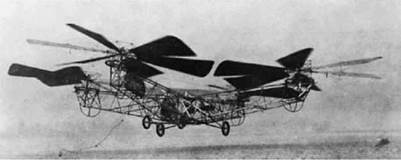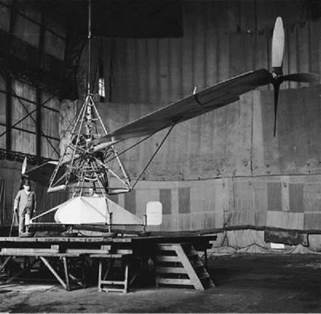First World War Era
In the First World War, Petroczy built a vertically lifting machine hoping to replace captive observation balloons, which were very vulnerable. The technical and experimental development was conducted by the illustrious Theodore von Karman. It consisted of two contrarotating rotors positioned within a framework which also contained three radial engines and the undercarriage was pressurized bags placed in the centre and at the end of three legs. An observation basket was placed above the rotors. Wilhelm Zurovec is often neglected in any description of this air vehicle except that the designation is PKZ (Petroczy Karman Zurovec).
In May 1918, thePKZ2 (see Figure 1.3), Hungary’s first military helicopter, flew tethered to a height of 50 m with new 31 hp Le Rhone engines.
1.1.2 Inter-war Years
In 1921 George de Bothezat directed the first US Army programme into helicopters. After working in secrecy at Dayton, the de Bothezat helicopter (see Figure 1.4), made its first flight in December 1922.
|
|
|
Figure 1.4 The de Bothezat Quadrotor |
The rotor layout was to have one rotor on each of four arms with the pilot positioned in the centre. Numerous flights were made in 1923 carrying up to four people. The US Army did not pursue the design but acknowledged its contribution to helicopter technology generally.
In the 1920s Emile Berliner developed a helicopter with the usual, at that time, layout of contrarotating rotors with vertical and horizontal vanes positioned under the rotor aiming, unsuccessfully, to give control. In 1922, the design moved into placing rotors on wing tips fitted to what was essentially a fixed-wing fuselage based on a Nieuport 23. Pitch control was achieved by a small propeller located just forward of the fin. The problems faced were those of not sufficient rotor size to generate sufficient thrust and blockage of the rotor downwash by the wing surfaces.
The French engineer Etienne Oehmichen began helicopter experiments by using balloons to assist the rotors in lifting the aircraft. In 1922, he was able to discard the balloon and use a four – rotor configuration. There were also five small, horizontal, variable pitch propellers to control the aircraft’s attitude in flight. Many flights were made lasting several minutes and in April 1923 the record distance of 358 m was achieved. In April 1924 Oehmichen raised the straight line distance record to 525 m only to have it broken the following day by the Spaniard, Marquis Pateras Pescara. In the following May he succeeded in flying a 1 km closed circuit course winning a 90000 franc prize from the Service Technique de L’Aeronautique.
Pescara flew for 736 m with a design of four biplane rotor blades on each of two rotors. These were placed on the same vertical axle and rotated in opposite directions. The pilot had control over the blade pitch and this helicopter was important in this respect as it heralded the use of autorotation for safe landing in the event of engine failure. Pescara attempted the closed course flight but was unsuccessful and it was left to Oehmichen to achieve this the following year.
In England Louis Brennan was developing his helicopter at the Royal Aircraft Establishment in Farnborough – see Figure 1.5. It was a two-bladed rotor powered by propellers fitted to the blade tips.
Thus external propulsion did not need torque reaction of a second rotor. Tethered flights inside a hangar were undertaken in 1924 with free flights beginning in 1925. They were halted in 1926 after an accident.
In 1925, the Dutch engineer Baumhauer developed a single two-bladed main rotor helicopter which had the beginnings of blade control via a swash plate system. It also had torque control provided by a separate vertical rotor, which was the forerunner of the modern day tail rotor. The flight of the helicopter was not altogether successful and chains were hung from the corners of the airframe to improve the stability. While ultimately unsuccessful, this design provided important technological pointers for the future.
The Hungarian engineer Oscar von Asboth developed a sequence of designs which comprised two contra-rotating main rotors and control was achieved using vanes placed in
|
Figure 1.5 Brennan helicopter |
the downwash. The fourth variant was the AH4 and in 1930 it climbed to a height of 31 m, flying a distance of 2800 m. Also in 1930 the Italian Corridon D’Ascanio broke three world records of altitude (59 feet) distance (1180 yards) and endurance (8 minutes, 45 seconds). The configuration consisted of two contra-rotating main rotors of two blades each. The blade pitch was controllable in flight by the pilot by means of trailing-edge-mounted tail elevators – a unique design feature at that time.
Also in the 1930s the Belgian Nicolas Florine was working on what is now termed the ‘tandem helicopter layout’. Both rotors spun in the same direction and the counteracting torque was provided by tilting the two rotor shafts appropriately.
Breguet now reappeared working with Rene Dorand. The Breguet-Dorand Gyroplane was so successful in its flight that many feel that it is the first real helicopter. It made its first flight in June 1935 after which flight tests and design amendments were made over the following months. December 1935 sawthis helicopter presented to the world and before the FAI itflewat 67 mph raising the world speed record further. In September 1936 it rose to a record 517 feet altitude and in November set the closed course record of 27.4 miles. The design had two twin – bladed rotors which were mounted on universal joints allowing the rotor discs to be used to control the helicopter flight. This is the beginning of the articulated rotor design.[2] Torque control was achieved by differential blade pitch on the two main rotors.
The final part of the early years of helicopter development is defined by the work of Henrich Focke in Germany. One year after the first flight of the Gyroplane, the Focke-Achgelis Fa61 flew for the first time. This used two three-bladed main rotors placed laterally on outriggers – the forerunner of the side-by-side configuration. It was very successful in breaking world records including 77 mph, 8000 feet altitude and an endurance of 1 h 20 min. It also flew a closed course of 50 miles. In February 1938, Hanna Reich flew this aircraft inside the Berlin Deutschlane Halle sports arena. It took off, hovered and flew sideways within the hall in front of many spectators. With the banked seating, recirculation was very apparent after a period of flight, with the consequence that much rubbish was seen flying through the air!
Alongside the development of the helicopter, the autogyro played a significant part in the evolution of its sibling. In January 1923 the Spaniard Juan de la Cierva achieved the first flight of an autogyro. The vehicle itself was developed from the airframe of a fixed-wing aircraft; the wings were shortened, a rotor was fitted above the centre of the fuselage and the empennage was retained virtually unmodified. It was designated the Cierva C-4. de la Cierva is one of the most respected rotorcraft pioneers and his work was very influential in the history of rotorcraft engineering. In September 1928 the first rotary-winged aircraft crossing of the English Channel took place when de la Cierva flew his C8L MkII, including a passenger from Croydon, to Le Bourguet. Figure 1.6 shows a later type – the C8V.
In the Soviet Union, the first tethered helicopter test took place in August 1930 with the Ts AGI1-EA.
In January 1939 a Kellett autogyro flew the first mail service for Eastern Airlines linking the main Post Office in Philadelphia, PA with Camden NJ Airport.














